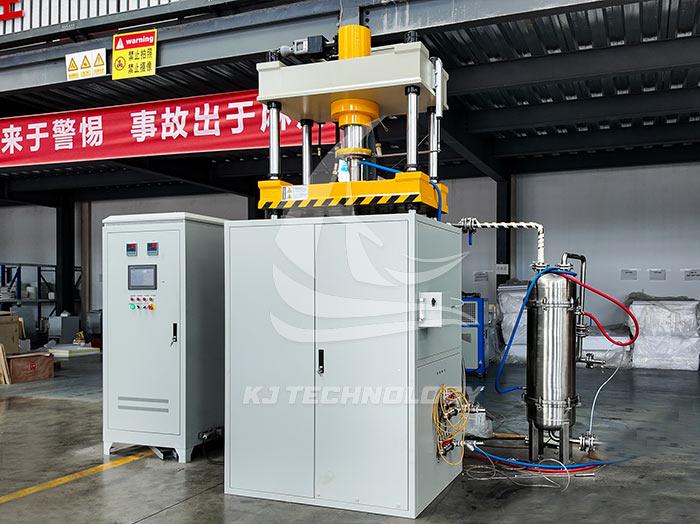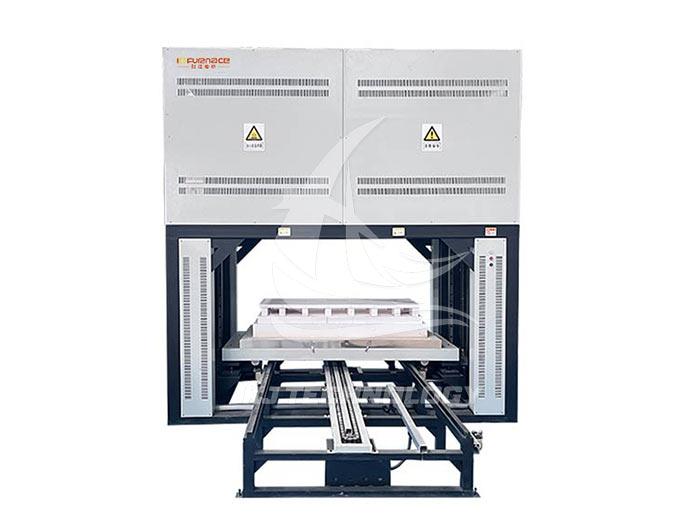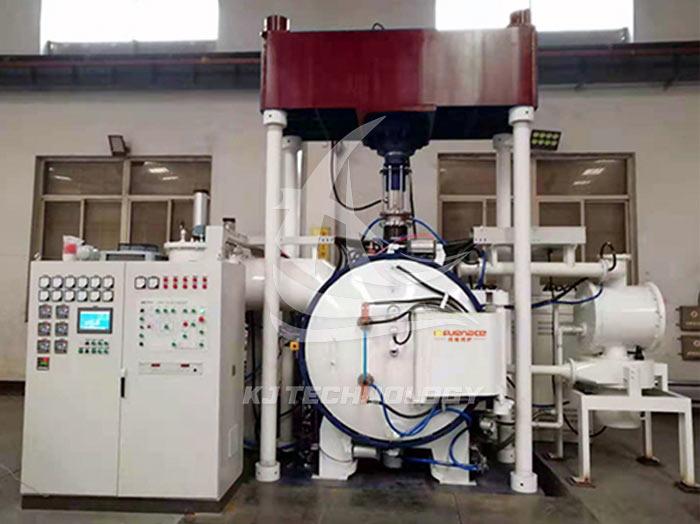What are the advantages of vacuum heat treatment furnaces in industrial production processes?
 05-19-2025 Author: KJ technology
05-19-2025 Author: KJ technology
Vacuum heat treatment furnaces have significant advantages in industrial production processes, which stem from their unique process principles and technical characteristics, and can meet the stringent requirements of modern industry for material properties and processing quality.
1. Material performance optimization
No oxidation, no decarburization
Principle: In high vacuum (≤ 10 ⁻ ² Pa) or low-pressure environments, metal materials are completely isolated from active gases such as oxygen and water vapor, avoiding the common problems of oxide scale and decarburization layer in traditional heat treatment.
Effect: Maintain the purity and smoothness of the material surface, reduce subsequent processing allowance, and improve material utilization. For example, stainless steel parts have a shiny surface after vacuum heat treatment, without the need for acid washing and polishing.
Uniformization of microstructure
Principle: The vacuum environment promotes atomic diffusion, accelerates the phase transition process, and makes the internal structure of the material more uniform and dense.
Effect: Significantly improve the hardness, toughness, wear resistance, and fatigue strength of the material. For example, after vacuum quenching, the hardness of high-speed steel cutting tools can reach HRC62 or higher, and the red hardness (high temperature hardness) is increased by 20% -30%.
Reduce deformation and cracking
Principle: Vacuum heat treatment uses slow heating and cooling rates to reduce thermal stress gradients and avoid cracking inside the material.
Effect: Especially suitable for heat treatment of precision parts and thin-walled components, such as aircraft engine blades, precision molds, etc.
2. Improvement of process quality
High precision temperature control
Technology: Equipped with high-precision sensors such as infrared thermometers and thermocouples, combined with a PID closed-loop control system, the temperature uniformity can reach within ± 5 ℃.
Application: Meet the processing requirements of temperature sensitive materials in the aerospace and electronics industries, such as solid solution treatment of titanium alloys and nickel based alloys.
Non polluting processing
Principle: The vacuum environment eliminates the pollution of chemical media such as salt baths and carburizing agents in traditional heat treatment, avoiding problems such as hydrogen embrittlement and intergranular corrosion.
Advantages: Especially suitable for heat treatment of biomedical materials (such as titanium alloy implants) and electronic components, ensuring material purity and reliability.
High repeatability of the process
Principle: Standardize process parameters (temperature, time, vacuum degree) and automation control system to ensure consistent quality of each batch of products.
Value: Reduce waste rate, improve production efficiency, and meet the needs of large-scale industrial production.
3. Energy saving and environmental benefits
Energy consumption reduction
Technology: Using ceramic fiber insulation materials, high-efficiency heating elements (such as graphite and molybdenum wire), and thermal cycling systems, the thermal efficiency can reach over 60%.
Comparison: Compared to traditional box furnaces, vacuum heat treatment furnaces save 30% -50% energy and significantly reduce long-term operating costs.
No harmful emissions
Environmental friendliness: The vacuum heat treatment process has no exhaust gas or wastewater discharge, and meets the requirements of ISO 14001 environmental management system.
Compliance: Help enterprises avoid environmental penalty risks and enhance the image of green manufacturing.
Efficient utilization of resources
Material savings: No oxide layer generated, material utilization rate increased by 10% -15%.
Circular economy: Waste can be recycled and reused, reducing resource waste.
4. Process flexibility
Multi process integration
Function: One device can achieve various processes such as quenching, annealing, tempering, aging, brazing, sintering, etc., reducing equipment investment and footprint.
Case: The vacuum oil quenching furnace can simultaneously complete quenching and low-temperature tempering, shortening the process cycle.
Adapt to new materials
Application: Suitable for heat treatment of difficult to machine materials such as high-temperature alloys, titanium alloys, hard alloys, ceramic materials, etc.
Advantage: Expand the application scope of materials and promote the development of high-end manufacturing industry.
Customized process
Service: We can develop exclusive process curves according to customer needs to meet special performance requirements.
Value: Enhance product added value and strengthen market competitiveness.
5. Economic benefits
Long term cost advantage
Comparison: Although the initial investment in equipment is relatively high, the cost can usually be recovered within 2-3 years through energy conservation, consumption reduction, and improved yield rate.
Case: After introducing vacuum heat treatment furnaces, a certain automotive parts company saved over one million yuan in energy costs annually, and the scrap rate decreased from 8% to 2%.
Enhance product added value
Market: Vacuum heat treatment products can have a premium of 10% -20% due to their excellent performance, increasing the profit margin of enterprises.
Brand: Enhance customer trust and assist enterprises in exploring high-end markets.
6. Technological development trends
Intelligent upgrade
Direction: integrating industrial Internet and big data analysis to achieve process parameter optimization and predictive maintenance of equipment.
Case: A certain enterprise has increased the yield rate of vacuum heat treatment to 99.5% through AI algorithms.
Ultra high temperature/ultra-low temperature technology
Breakthrough: Develop ultra-high temperature vacuum furnaces above 2000 ℃ and liquid nitrogen cooling systems at -196 ℃ to meet extreme working conditions.
Application: Hot end components for aerospace engines, preparation of superconducting materials.
Green Vacuum Technology
Innovation: Adopting oil-free vacuum pumps and hydrogen recovery systems to further reduce energy consumption and emissions.
Outlook: In line with global carbon neutrality goals, leading the industry towards sustainable development.
Summarize
The vacuum heat treatment furnace has become an indispensable key equipment in high-end manufacturing industry due to its five core advantages of material performance optimization, process quality improvement, energy conservation and environmental protection, process flexibility, and economic benefits. With the continuous advancement of technology and the expansion of application fields, its market prospects will become even broader, especially in strategic emerging industries such as aerospace, new energy vehicles, and medical equipment. The value of vacuum heat treatment furnaces will be further highlighted.








